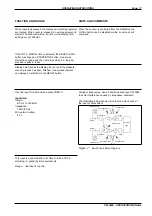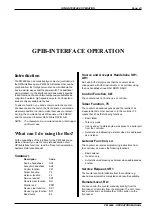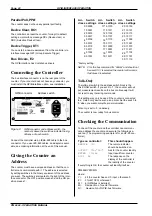
GPIB-INTERFACE OPERATION
Introduction
The PM 6666 can be controlled by a computer (controller) via
the GPIB-interface option, PM 9604. All functions that can be
controlled from the front panel can also be controlled via the
bus in a similar way, except the power switch. The additional
micro-processor on the interface board has made it possible
to add functions. You can obtain continuously variable Meas-
uring-time, bus-learn, high-speed-dump etc., but these func-
tions are only accessible via the bus.
To select a function, you send a command to the counter.
We have chosen the text on the front panel as commands,
wherever possible, in order to make them easy to remem-
ber. E.g. the command to select Frequency-C is FREQ C
and the command to select Ratio A/B is RATIO A,B.
NOTE:
The characters in a command can be in both upper
and lower case.
What can I do using the Bus?
All the capabilities of the interface for the PM 6666 are ex-
plained below. If you want a complete description of all
GPIB-interface functions, read the ‘Fluke Instrumentation-
Systems Reference-Manual’.
Summary
Description
Code
Source handshake
SH1
Acceptor handshake
AH1
Control function
CØ
Talker Function
T5
Listener function
L4
Service request
SR1
Remote/local function
RL1
Parallel poll
PPØ
Device clear function
DC1
Device trigger function
DT1
Bus drivers
E2
Source and Acceptor Handshake SH1,
AH1
SH1 and AH1 simply means that the counter can ex-
change data with other instruments or a controller, using
the bus handshake lines; DAV, NRFD, NADC.
Control Function, CØ
The counter does not function as a controller.
Talker Function, T5
The counter can send responses and the results of its
measurements to other devices or to the controller. T5
means that it has the following functions:
–
Basic talker.
–
Talk only mode.
–
It can send out a status byte as response to a serial poll
from the controller .
–
Automatic un-addressing as talker when it is addressed
as a listener.
Listener Function, L4
The counter can receive programming instructions from
the controller. L4 means the following functions:
–
Basic listener.
–
No listen only.
–
Automatic un-addressing as listener when addressed as
a talker.
Service Request, SR1
The counter can call for attention from the controller e.g.
when a measurement is completed and a result is available.
Remote/Local, RL1
You can control the counter manually (locally) from the
front panel, or remotely from the controller. The LLO, local-
lock-out function, can disable the LOCAL button on the
front panel.
GPIB-INTERFACE OPERATION
Page: 23
PM 6666 - OPERATORS MANUAL






























